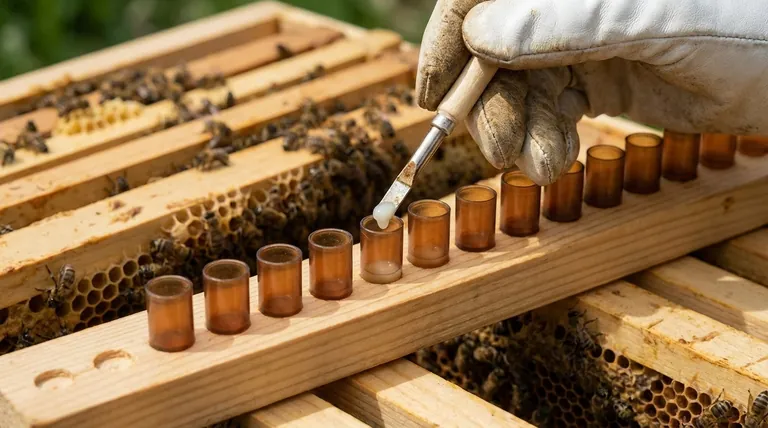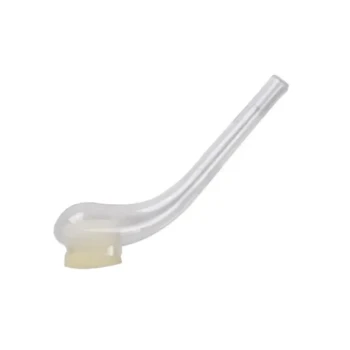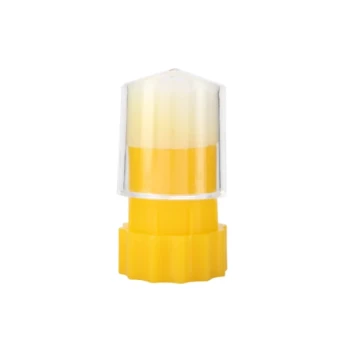The primary purpose of priming cell cups before grafting is to create a hospitable environment for the young larva. By adding a small drop of diluted royal jelly, you prevent the incredibly delicate larva from drying out and provide it with an immediate source of nutrition, significantly increasing the chances that the graft will be accepted and cared for by the colony.
Priming is not merely a procedural step; it is the act of simulating the natural conditions of a new queen cell. This mimicry is the key to convincing the nurse bees that the grafted larva is a queen-in-waiting, triggering their instinct to nurture it.

Why Priming Is a Critical First Step
Successfully raising queens is about managing details, and priming is one of the most crucial. It directly influences whether a grafted larva lives or dies in the first few minutes and whether the colony accepts or rejects it.
Preventing Larval Desiccation
A honey bee larva in its first day of life is over 90% water and has an extremely thin, permeable skin. When you transfer it from its bed of royal jelly into a dry plastic or wax cell cup, it begins to lose moisture immediately. This desiccation is a primary cause of grafting failure.
A primed cell cup provides a humid, moist bed that protects the larva from the shock of a dry environment, giving it the stability it needs to survive the transfer.
Simulating a Natural Queen Cell
In a natural hive environment, a cell destined for a queen is never dry. Worker bees prepare it with a base layer of royal jelly, into which the queen lays the egg.
By priming the cup, you are replicating this natural signal. You are telling the nurse bees, "This cell is prepared and ready for a queen." A dry, empty cell cup is an anomaly that bees are more likely to ignore or clean out.
Encouraging Acceptance by Nurse Bees
The ultimate goal of grafting is to have the colony's nurse bees "accept" the larva and begin feeding it copious amounts of royal jelly. The presence of that initial drop of food acts as a powerful trigger.
When nurse bees inspect a primed cell, they find a larva already situated on a familiar food source. This encourages them to immediately begin their work, adding more royal jelly and building out the queen cell.
Understanding the Trade-offs and Common Pitfalls
While highly effective, priming must be done correctly. Simply adding royal jelly is not enough; the quality and consistency matter.
The Risk of Contamination
Royal jelly is a rich nutrient source not just for larvae, but for bacteria and fungi as well. Using old, improperly stored, or contaminated royal jelly can introduce pathogens that will kill the larva.
Always use fresh royal jelly harvested from a strong, healthy colony or a commercially sourced product that has been stored correctly (frozen or refrigerated).
Incorrect Consistency
The priming mixture—typically royal jelly thinned with a small amount of distilled water—must have the right consistency.
If it is too thick, it can be difficult to place the larva correctly. If it is too thin and watery, the larva can essentially drown or be washed to the side of the cell. The ideal consistency is milky and just fluid enough to form a small, stable droplet.
The Debate on Necessity
Some highly experienced, high-volume queen producers skip the priming step to save time. They rely on extreme speed and a humidity-controlled grafting environment to transfer larvae before they can dry out.
For the vast majority of beekeepers, this is an unnecessary risk. The time saved is minimal compared to the potential drop in your graft acceptance rate. For anyone learning or aiming for maximum success, priming is not optional.
How to Apply This to Your Goal
Your approach to priming should be dictated by your experience level and primary objective.
- If your primary focus is maximizing success and learning the process: Always prime your cell cups. It is the single most effective way to buffer against small errors in speed or environment and dramatically increase your acceptance rate.
- If your primary focus is high-volume, high-speed production: You may experiment with "wet grafting" (transferring the larva with some of its original royal jelly) or no priming at all, but only if you have a humidity-controlled space and can complete grafts in seconds.
- If you do not have a source of royal jelly: Your next best option is to perform a wet graft. Carefully scoop the larva along with a generous portion of the royal jelly from its original cell to serve the same protective function.
Ultimately, priming is a small investment of time that pays significant dividends in the health and survival of your future queens.
Summary Table:
| Purpose of Priming | Key Benefit |
|---|---|
| Prevent Larval Desiccation | Protects the delicate larva from drying out during transfer. |
| Simulate a Natural Queen Cell | Triggers nurse bee instincts to accept and nurture the graft. |
| Encourage Immediate Care | Provides an immediate food source, prompting bees to add royal jelly. |
Ready to elevate your queen rearing operation?
HONESTBEE supplies commercial apiaries and beekeeping equipment distributors with the high-quality, reliable supplies needed for successful grafting and queen production. From durable cell cups to other essential beekeeping equipment, our wholesale-focused operations are designed to support your business's growth and efficiency.
Contact us today to discuss your needs and discover how we can help you achieve higher success rates.
Visual Guide

Related Products
- Brown Nicot Queen Cell Cups for Breeding Queen Bees Beekeeping
- JZBZ Push-In Queen Cell Cups for Beekeeping
- Stainless Steel Queen Grafting Tool for Beekeeping and Bee Queen Grafting
- JZBZ Type Wide Base Plastic Queen Cell Cups for Base Mounting and Queen Rearing
- Clear Black Plain Polystyrene Queen Bee Grafting Cell Cups No Lug for Bee Queen Cup
People Also Ask
- What are the ideal conditions for raising good queen cells? Achieve Robust Queens with Strong Cell-Builder Colonies
- What is the advantage of the Nicot Cupkit system? Secure Your Queen Rearing Success with Batch Protection
- How are the queen cells raised after removing the plugs? Master the Art of Queen Rearing
- How many cells are given to a nucleus? Understand the One-to-One Rule in Cell Biology
- Why is it important to select a healthy larva less than 24 hours old for queen rearing? Maximize Queen Quality and Colony Strength














